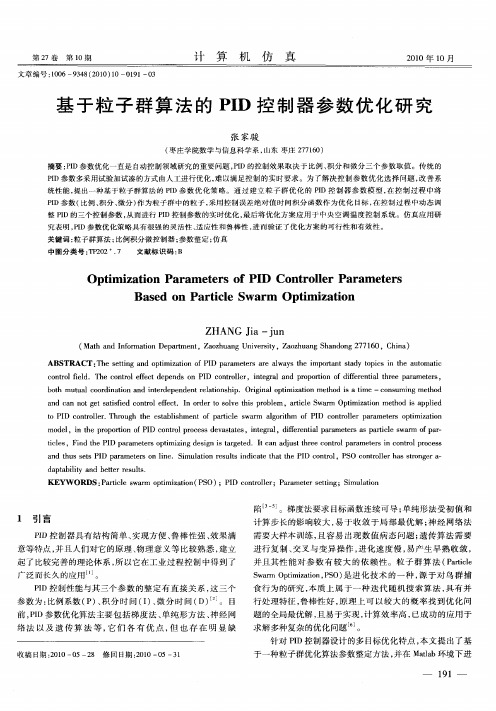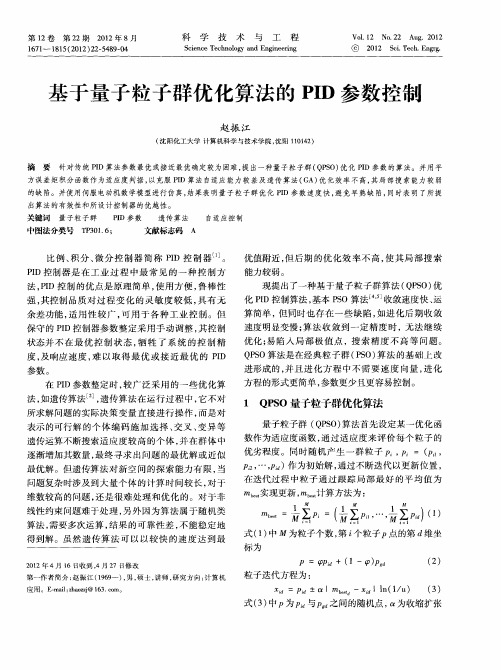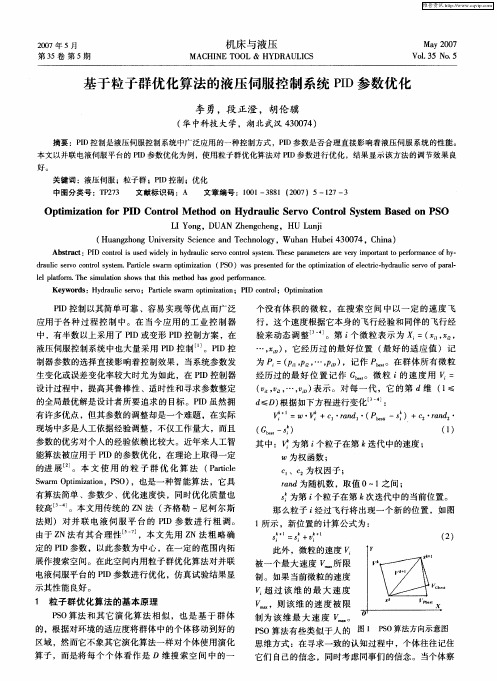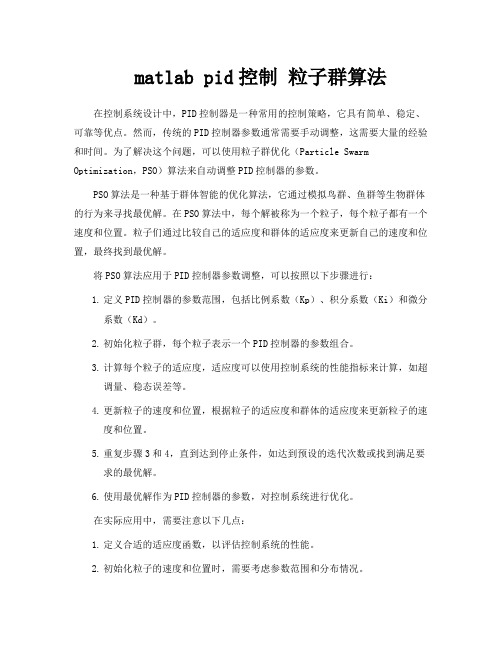基于粒子群算法的控制系统PID参数优化设计
基于粒子群算法的PID控制器优化设计

figure(2) plot(K_p) hold on
% 绘制 PID 控制器参数变化曲线
plot(K_i,'k','LineWidth',3) plot(K_d,'--r') title('Kp、Ki、Kd 优化曲线','fontsize',18); xlabel('迭代次数','fontsize',18);ylabel('参数值','fontsize',18); set(gca,'Fontsize',18); legend('Kp','Ki','Kd',1);
二、问题描述
PID 控制器的系统结构图如图 1 所示。
r(t)
e(t)
PID控制器
被控对象
y(t)
图 1 PID 控制器系统结构图 PID 控制器的优化问题就是确定一组合适的参数 Kp、Ki、Kd,使得指标达到最优。常用的 误差性能指标包括 ISE、IAE、ITAE 等,这里选用 ITAE 指标,其定义为
J t | e(t ) | dt
0
(2)
选取的被控对象为以下不稳定系统:
G(s)
s2 s 8s 4s 2 s 0.4
4 3
(3)
在 simulink 环境下建立的模型如图 2 所示。 图 2 中,微分环节由一个一阶环节近似,输出端口 1 即为式(2)所示的 ITAE 指标,通 过将时间及误差绝对值乘积进行积分后得到。
2、PSO 部分的程序实现
设置 PSO 的参数为:惯性因子 0.6 ,加速常数 c1 c2 2 ,维数为 3(有 3 个待优 化参数) ,粒子群规模为 100,待优化函数为 PSO_PID 函数,最大迭代次数为 100,最小适 应值为 0.1,速度范围为[-1,1],3 个待优化参数均为[0,300],代码如下:
基于粒子群算法的PID控制器参数优化研究

mo e ,i e p o o in o I o t l r c s e a t ts n e a ,df r n il aa t r sp ril wa f a - d l n t r p r o fP D c n r o e sd v sae ,i tg l i e e t r me e sa a t e s r o r h t op r f ap c m p
t ls Fn eP D p rm t so t i n ei ree .I C la js trecnrl a m t s nc nr rc s i e , i t I a ee pi z g s ni t g t c dh a r m i d g sa d t a d t he o t r ee o t l oe s l u op a ri op
PD参 数 ( I 比例 、 分 、 分 ) 为 粒 子群 中 的粒 子 , 用 控 制 误 差 绝 对 值 时 间 积 分 函数 作 为 优 化 日标 , 控 制 过 程 中动 态 调 积 微 作 采 在
整 PD的三个控制参数 , I 从而进行 PD控制参数的实时优化 , I 最后 将优化方案应用于 中央空调温度控制 系统。仿真应用研
Z HANG Ja— in i a
( ahadIfr t nD pr et Z oh agU i rt, azun hn og27 6 ,C i ) M t n no i eat n, azun nv s y Z oh agS ad n 7 10 hn mao m ei a
A BS TR ACT : e s ti g a d o tmiai n o D a a tr r l y h mpot n t d o i si h uo ai Th e tn n pi z to fPI p r mee s a e awa st e i ra tsa y tp c n t e a tm tc
粒子群算法优化PID控制参数研究

控 制器 设 计
.
《 电气 自动化) 0 6年第 2 20 8卷 第 4期
Cont ol r r l e Des ̄ in l
— — — — — —
粒 子群算 法优化 P 制参数研 究 I D控
Re e r h n arce s a c o P t l Swa m Op i z t n i r t mia i Alo i m t Op i z PI o g rh t o t mie D Co tolrPa a t s n r l r me er e
在解空 间中摸索 。每个粒子根据 自己和其它粒子 的‘ 飞行经验 ” 群 游, 从而达到从全空 间搜索最优解的 目的。具体搜索过程如下 :
每 个 粒 子 在 解 空 间 中 同 时 向两 个 点 从 接 近 ,第一 个点 是整 个
要求对被控 过程 和控 制规律有全面的先 验知识 。或建立在要求具 有连续导数的光滑搜 索空间的基础 上。若参数空 间不 可微或参数
法用 的交 叉 (rs vr以及变 异 ( ua o) cos e) o m ti 。而是 粒子 在 解空 间 追 随 tn
上 海 电 机 学 院 电气 学 院 ( 海 20 4 ) 付 n h i in i nvr t S a g a 0 2 0 C ia F ioa g j Lxa S a g a a J U i s y h n h i 0 4 , h ) u X ag n i i D e i, 2 n i
公 式 来 更 新 自己 的速 度 和 新 的 位 置 :
t ,J=W★ l l J+c ★r d ) p et J—pee t ) l a ( ★( b sl n rsn l J () 1
行为研究 ,S P O同遗传算法类似 , 是一种基于叠代 的优化工具 。系 】 统初始化为一组 随机解,通过叠代搜寻最优值 。但是并没有遗传算
粒子群算法优化模糊 pid

粒子群算法优化模糊 pid
模糊 PID 控制器是一种基于模糊逻辑的 PID 控制器,它结合了传统 PID 控制器和模糊控制的优点,可以更好地适应复杂的非线性系统。
粒子群算法是一种启发式全局优化算法,通过粒子间的合作与竞争来寻找最优解。
在模糊 PID 控制器的设计中,PID 参数的选择对控制器的性能有着重要的影响。
传统的 PID 参数整定方法往往需要依赖经验或者试错,而粒子群算法可以用于优化模糊 PID 控制器的参数,以提高控制器的性能。
具体来说,可以将模糊 PID 控制器的参数作为粒子群算法的搜索空间,通过粒子群算法的迭代来寻找最优的参数组合。
在粒子群算法中,每个粒子代表一个候选的参数组合,粒子的位置和速度可以根据粒子的历史最优位置和全局最优位置进行更新。
在优化过程中,可以通过模糊规则来调整 PID 参数的取值范围,以保证控制器的稳定性和鲁棒性。
同时,可以使用适应度函数来评价控制器的性能,以指导粒子群算法的搜索方向。
总的来说,使用粒子群算法优化模糊 PID 控制器的参数可以提高控制器的性能和自适应能力,是一种有效的方法。
基于量子粒子群优化算法的PID参数控制

第2 2期
21 0 2年 8月
科
学
技
术
与
工
程
Vo.1 No 22 Aug 2 2 1 2 . . 01
17 — 1 1 f 0 2 2 —49 O 6 1 8 5 2 1 )2 58 -4
S in eT c n lg n n n e n c c e h oo ya d E  ̄ e 6 g e
出算法 的有 效性和所设计控制器 的优越性。 关 键词 量 子粒 子群 PD参数 I 遗传算法 A 自适应控 制 中图法分类号 T 3 16 P0. ; 文献 标志码
比例 、 分 、 分 控 制 器 简 称 PD 控 制 器 j 积 微 I 。 PD控 制 器 是 在 工 业 过 程 中最 常见 的一 种 控 制 方 I 法 ,I PD控 制 的优 点 是 原 理 简 单 , 用 方 便 , 棒 性 使 鲁 强 , 控制 品质 对 过 程 变 化 的灵 敏 度 较 低 , 有 无 其 具
优值附近, 但后期 的优化效率不 高, 使其局部搜 索
能力 较弱 。
现提 出 了一种基 于量 子 粒 子 群 算 法 ( P O) Q S 优 化 PD控制算 法 , I 基本 P O 算法 _ 收敛 速度快 、 S 4 运
余差功能 , 适用性 较广 , 可用 于各种工业 控制。但 保守的 PD控制器参数整定采用手动调整 , I 其控制
⑥
2 1 SiT c. nr. 0 2 c. eh E gg
基于量子粒子群优化算法 的 PD参数控制 I
赵振 江
( 沈阳化 工大学 计算机科学与技术学院 , 沈阳 10 4 ) 1 12
摘
要
针 对传 统 PD算法参数最优或接近最优确定 较为困难, 出一种量 子粒子群 ( P O 优 化 PD参 数的算法。并用平 I 提 QS) I
基于粒子群优化算法的液压伺服控制系统PID参数优化

L o g U N Z e gh n ,H uj IY n ,D A h nc e g U L ni
( u n zogU i ri c neadT c n l y Wu a u e 4 07 C ia H a ghn nv sySi c n eh oo , h nH b i 3 0 4, h ) e t e g n
Ab t a t I o t l su e i ey i y r u i e v o t l y tm. h s a a tr r ey i o tn e fr n eo y sr c :P D c nr s d w d l h d a l s r o c nr se T e e p rmee sa e v r oi n c os mp r tt p r ma c f ・ a o o h
的全局最优解是设计 者所要追求 的 目标。PD虽然拥 I
。第 个微 粒表 示为 X =( ¨ ,
,
。
) ,它经历 过 的最好位 置 ( 最好 的适 应值 )记
为 P =( P , P ,记作 P 。在 群体所有微粒 P …, )
经历 过的最好 位 置 记 作 G 。微 粒 的 速度 用 =
好。
关键词 :液压伺服 ;粒子群 ;PD控制 ;优化 I
中图分类号 :T 2 3 P 7 文献标识码 :A 文章编号 :10 —3 8 20 )5—17—3 0 1 8 1(0 7 2
Op i ia o o I Co to eh d o d a l e v n r lS se sd o S t z t n f r P D n r l m i M t o n Hy r u i S r o Co to y tm Ba e n P o c
matlab pid控制 粒子群算法

matlab pid控制粒子群算法在控制系统设计中,PID控制器是一种常用的控制策略,它具有简单、稳定、可靠等优点。
然而,传统的PID控制器参数通常需要手动调整,这需要大量的经验和时间。
为了解决这个问题,可以使用粒子群优化(Particle Swarm Optimization,PSO)算法来自动调整PID控制器的参数。
PSO算法是一种基于群体智能的优化算法,它通过模拟鸟群、鱼群等生物群体的行为来寻找最优解。
在PSO算法中,每个解被称为一个粒子,每个粒子都有一个速度和位置。
粒子们通过比较自己的适应度和群体的适应度来更新自己的速度和位置,最终找到最优解。
将PSO算法应用于PID控制器参数调整,可以按照以下步骤进行:1.定义PID控制器的参数范围,包括比例系数(Kp)、积分系数(Ki)和微分系数(Kd)。
2.初始化粒子群,每个粒子表示一个PID控制器的参数组合。
3.计算每个粒子的适应度,适应度可以使用控制系统的性能指标来计算,如超调量、稳态误差等。
4.更新粒子的速度和位置,根据粒子的适应度和群体的适应度来更新粒子的速度和位置。
5.重复步骤3和4,直到达到停止条件,如达到预设的迭代次数或找到满足要求的最优解。
6.使用最优解作为PID控制器的参数,对控制系统进行优化。
在实际应用中,需要注意以下几点:1.定义合适的适应度函数,以评估控制系统的性能。
2.初始化粒子的速度和位置时,需要考虑参数范围和分布情况。
3.在更新粒子的速度和位置时,需要平衡全局搜索和局部搜索的能力。
4.需要根据具体的应用场景和要求来确定停止条件和最优解的评估标准。
5.需要考虑控制系统的约束条件和系统的稳定性。
综上所述,将粒子群优化算法应用于PID控制器参数调整是一种有效的优化方法。
通过使用粒子群优化算法,可以自动调整PID控制器的参数,提高控制系统的性能和稳定性。
在实际应用中,需要根据具体的应用场景和控制要求来确定算法的参数和最优解的评估标准。
基于粒子群算法的PID控制器研究与应用

P O算法 即粒子群优化算法,它是对鸟群觅食 过程 中的 S 迁徙和聚集的模拟 ,更确切地说是 由简单个体组成的群 落与 环境 以及个体之间的互动行为 。该算法是利用 局部个体的行 为, 而预 测整个群体 的运动趋势 ,目前在工业控制、 函数 参数
21 02年第 4期
( 总第 10期) 2
信 息 通 信
I NFORM AT ON & CO^ 仉 C I NI ATI ONS
2 l 02
(u . N 2 ) Sm o 1 0
基于粒子群算法 的 PD控制器研 究与应用 I
孙 静
( 乡职业技术 学院 , 新 河南 新 乡4 3 0 ) 5 0 0
() 2 使用形态学的开. 闭运算和 闭. 开运算可 以去除脉搏信
搏波检测算法[]电子测量技术 ,0 l3 ( )7 9 J. 2 1 ,4 6 :17 [】 胡学龙 . 7 数字图像 处理 ( 2版)M]北京: 第 [ . 电子工业出版
社 ,0 1 1512 2 1 :7 .8
号图中小于结构元素 的噪声 。
时域 方 程 中 的后 两 项 可 以用 数 值 逼 近 法 近 似 。下 列 方 程 式 的 采 样 周 期 为 T采 样 点 tk = T。
r I 1
优化等方面。本文将利用粒子群算法对 PD控制器的参数进 I
行优化研究 。
1基于粒子群算法的 PD参数优化 I
11 I . P D控 制器 PD控制是将偏差 的比例、 I 积分和微分通过线性组合构成
性、 适应性和鲁棒性 , 而验证 了优化方案的可行性和有效性。 进 关键词: 粒子群算法; 比例积分微控制器; 参数整定参 中图分类号 :P 7 文献标识码 : 文章编号 :6313(020—05 2 T 23 A 17.112 1 ) 03— 4 0
- 1、下载文档前请自行甄别文档内容的完整性,平台不提供额外的编辑、内容补充、找答案等附加服务。
- 2、"仅部分预览"的文档,不可在线预览部分如存在完整性等问题,可反馈申请退款(可完整预览的文档不适用该条件!)。
- 3、如文档侵犯您的权益,请联系客服反馈,我们会尽快为您处理(人工客服工作时间:9:00-18:30)。
基于粒子群算法的控制系统PID 参数优化设计摘 要本文主要研究基于粒子群算法控制系统PID 参数优化设计方法以及对PID 控制的改进。
PID 参数的寻优方法有很多种,各种方法的都有各自的特点,应按实际的系统特点选择适当的方法。
本文采用粒子群算法进行参数优化,主要做了如下工作:其一,选择控制系统的目标函数,本控制系统选用时间乘以误差的绝对值,通过对控制系统的逐步仿真,对结果进行分析。
由于选取的这个目标函数的解析式不能直接写出,故采用逐步仿真来实现;其二,本文先采用工程上的整定方法(临界比例度法)粗略的确定其初始的三个参数p K ,i K ,d K ,再利用粒子群算法进行寻优,得到更好的PID 参数;其三,采用SIMULINK 的仿真工具对PID 参数优化系统进行仿真,得出系统的响应曲线。
从中发现它的性能指标,都比原来有了很大的改进。
因此,采用粒子群算法的优越性是显而易见的。
关键词 目标函数;PID 参数;粒子群算法;优化设计;SIMULINKOptimal design of PID parameter of the control system based on Particle Swarm OptimizationAbstractThe main purpose of this paper is to study the optimal design of PID parameter of the control system based on Particle Swarm Optimization and find a way to improve the PID control. There are a lot of methods of optimization for the parameters of PID, and each of them has its own characteristics. The proper methods need to be selected according to the actual characteristics of the system. In this paper we adopt the Particle Swarm Optimization to tune the parameters. To finish it, the following tasks should be done. First, select the target function of the control system. The target function of the control system should be chosen as the absolute value of the error multiplied by time. Then we simulate the control system gradually, and analyze the results of the process. Because the solution of the target function cannot be worked out directly, this design adopts simulation gradually. Second, this paper adopts the engineering method (the critical ratio method) to determine its initial parameters p K ,i K ,d K , then uses the Particle Swarm Optimization to get a series better PID parameters. Third, this paper uses the tool of SIMULINK to optimize the parameters of PID and gets the response curve of the system. By contrast with the two response curves, it is clearly that the performance has improved a lot than the former one. Therefore, it is obviously to find the advantages in using the Particle Swarm Optimization.Key word : target function; PID parameters; Particle Swarm Optimization; optimal design; SIMULINK目录摘要 ...................................................................................................... 错误!未定义书签。
Abstract................................................................................................... 错误!未定义书签。
第1章绪论 ........................................................................................ 错误!未定义书签。
1.1 研究背景和课题意义 ..................................................................... 错误!未定义书签。
1.2 基本的PID参数优化方法 (1)1.3 常用的整定方法 (2)1.4 本文的主要工作 (4)第2章粒子群算法的介绍 ................................................................ 错误!未定义书签。
2.1 粒子群算法思想的起源 (5)2.2 算法原理 (5)2.3 算法流程 (6)2.4 全局模型与局部模型 (7)2.5 算法特点 (8)2.6 带惯性权重的粒子群算法 (8)2.7 粒子群算法的研究现状 (9)第3章用粒子群方法优化PID参数 (10)3.1 PID控制原理 (10)3.2 PID控制的特点 (11)3.3 优化设计简介 (11)3.4 目标函数选取 (12)3.5 大迟滞系统 ..................................................................................... 错误!未定义书签。
3.6加热炉温度控制简介 ..................................................................... 错误!未定义书签。
3.7 加热炉系统的重要特点 ................................................................. 错误!未定义书签。
3.8 加热炉的模型结构 ......................................................................... 错误!未定义书签。
第4章系统仿真研究 ........................................................................ 错误!未定义书签。
4.1工程上的参数整定 ......................................................................... 错误!未定义书签。
4.2 粒子群算法参数整定 ..................................................................... 错误!未定义书签。
4.3 结果比较 ......................................................................................... 错误!未定义书签。
4.4 P、I、D参数对系统性能影响的研究........................................... 错误!未定义书签。
4.5 Smith预估补偿器............................................................................ 错误!未定义书签。
结论 ........................................................................................................ 错误!未定义书签。
致谢 ........................................................................................................ 错误!未定义书签。
参考文献 ................................................................................................ 错误!未定义书签。
附录A(程序清单).. (29)附录B(外文文献) (32)附录C(中文译文) (49)第 1 章 绪论1.1 研究背景和课题意义在现代工业控制领域,PID 控制器由于其结构简单、鲁棒性好、可靠性高等优点得到了广泛应用。
PID 的控制性能与控制器参数d i p K K K ,,的优化整定直接相关。
在工业控制过程中,多数控制对象是高阶、时滞、非线性的,所以对PID 控制器的参数整定是较为困难的。
优化问题是工业设计中经常遇到的问题,许多问题最后都可以归结为优化问题。
为了解决各种各样的优化问题,人们提出了许多优化算法,比较著名的有爬山法、神经算法和遗传算法等。
优化问题有两个主要问题。
一是要求寻找全局最小点,二是要求有较高的收敛速度。
